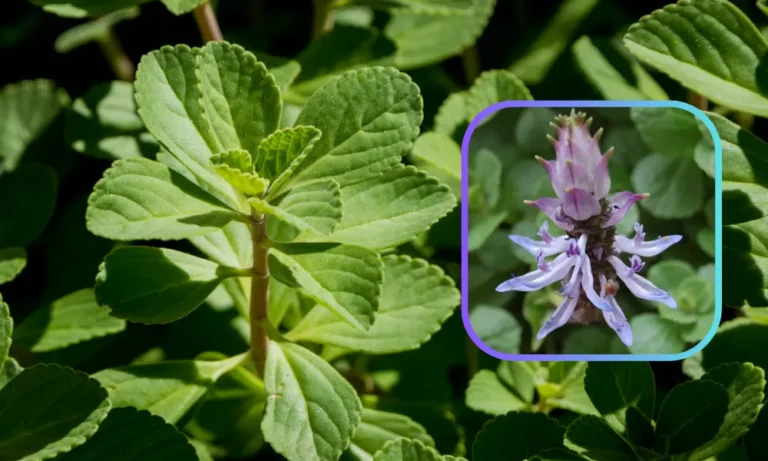The Panadol plant, scientifically known as Plectranthus caninus (formerly Coleus caninus), is a versatile herb with a multitude of practical uses. From medicine to culinary arts and landscaping, this herb offers many benefits when cultivated and employed correctly. Belonging to the mint family (Lamiaceae), this tender herb graces us with its presence in both Africa, specifically the southern and eastern regions, and South Asia.
Panadol is a pretty plant for your garden. It has oval-shaped, gray-green leaves that are about 3 inches long. In late spring and summer, it sprouts unique dark violet-blue flowers on spikes that can reach up to 8 inches. The Paracetamol plant provides benefits by producing a compound that helps reduce pain and lower fever. This natural remedy is commonly used to alleviate various discomforts, providing relief for headaches, muscle aches, and fevers.
Botanical Characteristics
Upon initial observation, the Panadol plant might be mistaken for its close botanical relatives. Its vibrant leaves are visually pleasing, neatly encircling upright stems. Depending on environmental factors, these stems can thrive as annuals or endure as short-lived perennials. Thanks to their leafy moisture reserves, they can be classified as semi-succulents.
Traditionally, the Panadol plant has been employed to combat colds, teeth issues, and gum ailments. It also adds a unique twist to seasoning mixes. Thanks to its distinct aroma and slightly bitter flavor. However, its potent medicinal scent and overpowering taste render it less suitable for extensive culinary endeavors.
Medicinal Uses of Panadol Plant

Herbalists have celebrated the myriad applications of cultivating Panadol, yet its full potential in pharmaceutical research remains largely unexplored. Nevertheless, novice gardeners and culinary enthusiasts alike can appreciate its lavender blooms and perhaps brew a soothing cup of tea from its leaves.
Panadol possesses a treasure trove of essential oils. When extracted and harnessed correctly, these oils can be incorporated into herbal remedies for various ailments. The leaves and branched taproot harbor phytochemicals that may alleviate gum and dental issues. Root extracts have potential in addressing coughs.
Panadol Phytochemical Benefits
Much like its minty relatives, Panadol yields beneficial phytochemicals when brewed into tea. Boiling the leaves releases anti-inflammatory and antimicrobial compounds, offering relief for oral, digestive, and respiratory discomfort. Furthermore, the Panadol plant boasts cytotoxic and antioxidant properties, which hold promise in treating more serious conditions like cancer.
Historically, the Panadol plant was coveted for its perceived medicinal properties, often brewed into a soothing tea. Crafting Panadol bush tea is a breeze:
- Add Panadol plant leaves to boiling water.
- Let it steep for 15 to 30 minutes.
- Enjoy it cool or reheat when desired.
- Many attest to its efficacy in treating colds, as well as dental and gum issues.
Ancient Remedies
Traditionally, Panadol leaves and its botanical kin have treated skin ailments and aided nursing mothers in breast cleansing. These antimicrobial leaves, emitting an aroma reminiscent of eucalyptus, likely act as a safeguard against skin infections. Responsible usage, including dilute tea concentrations or spot-testing the leaves, is advisable for all herbal remedies.
Essential Oil Components
Panadol’s essential oil primarily consists of camphor and a-thujene. Camphor, a monoterpene, serves as a topical remedy and antitussive (inhaled). It is renowned for its antibacterial, antifungal, and anti-inflammatory properties, providing relief for mouth pain, itching, and cough, though scientific validation is needed.
A-thujene, another monoterpene, offers mild pain relief and antibacterial protection, contributing to Panadol’s potent aroma and robust flavor. These components, combined with trace compounds, demonstrate efficacy against a range of pathogens, underlining the Panadol plant’s potential in treating microbial disorders.
Medicinal Properties
A prevalent misconception suggests that Panadol contains paracetamol. In truth, the Panadol plant does not contain any trace of this analgesic compound. The confusion likely stems from the existence of the drugstore product “Panadol.” While some “Panadol” products contain paracetamol, they do not emulate the effects of the Panadol plant. Any similarities arise from their shared antimicrobial properties, rather than chemical composition.
Panadol bush contains compounds like Camphor and Alpha Thujene (a-thujene), which offer:
- Reduction in inflammation
- Mild pain relief
- Protection against germs and bacteria
- Antibacterial, antifungal, and anti-inflammatory properties
These attributes partially explain the plant’s historical comparisons to Panadol.
Use of Panadol in the Kitchen
Adventurous home cooks can employ Panadol as a seasoning for flavorful dishes. With a texture and fragrance akin to oregano, its crushed leaves introduce complexity to various culinary creations. Slightly bitter, these leaves blend harmoniously with other herbs, forming a versatile seasoning for different meat dishes. Exercise caution when experimenting with the quantity of Panadol leaves in your recipes.
Cultivating Panadol

Panadol naturally sprawls as a low-growing herb, rarely exceeding 60 cm (24 inches) in height. In the wild, it thrives in communal clusters near rocky outcrops, beneath towering trees, or in open, arid woodlands. When cultivating it in your garden, choose well-draining soil and provide full to partial sunlight.
Hardy in USDA zones 10 – 11, Panadol flourishes in warm climates and loamy to sandy soils that facilitate root expansion. Under optimal conditions, it grows rapidly. If planted alongside other delicate herbs, consider containing its roots within pots or containers. In temperate regions, it can be cultivated as an annual, with ample time in spring and summer for abundant leaf and bloom production.
Thriving in zones 10 and 11, with potential winter survival in zones 9 and 8 when mulched. This drought-tolerant plant requires supplemental watering only during elevated summer temperatures
Planting Panadol
Panadol thrives in warm regions and can germinate when soil temperatures exceed 15.5˚C (60˚F). Seeds can be collected from dried flower heads and sown indoors or in a protected outdoor location, particularly in temperate areas where greenhouse cultivation is advisable before the final frost.
Sow Panadol seeds in pre-moistened, sterile starter mix, maintaining warmth and partial light for germination. After a few weeks, seedlings with their initial true leaves can be carefully transplanted into individual pots. Once they reach a manageable size, they can be relocated outdoors, weather permitting.
Safety Precautions
Given its complex aromatic essential oil, Panadol has the potential to be toxic when ingested in large quantities, leading to adverse effects like nausea and vomiting. Use conservative doses when cultivating for herbal purposes. Additionally, the plant’s strong scent deters scent-sensitive animals like cats and dogs, making it a wise choice for pet owners. However, be aware that the camphor-rich leaves are toxic to livestock.
Not an Invasive Species
Fortunately, Panadol is not considered invasive, even though it can grow and spread rapidly. While it has naturalized outside its native range, it does not cause ecological harm. In contrast, many of its mint family relatives are known for their invasive tendencies.
Where to Find Panadol?
Interested individuals can purchase Panadol seeds or young plants from nurseries, commercial herb gardens, or online plant vendors. Before acquiring this species, ensure your local conditions support its growth. Be mindful that Panadol’s presence may affect pets adversely.
Origins and Growth

The Panadol plant (Plectranthus Caninus Roth) was initially identified and collected in India, but it has since journeyed across the globe. While it’s listed as a native plant in parts of Africa, detailed information remains elusive. Another similar-looking plant with slight variations exists.
I received my Panadol plant cuttings from a friend in Trinidad, where it thrives, thanks to the island’s substantial Indian population. In some areas, you can even encounter wild Panadol bushes.
Growing the Panadol plant is remarkably straightforward. Here are some pointers to ensure its success:
- Keep cuttings moist until they begin to sprout.
- Opt for well-drained soil, although it can tolerate brief waterlogging.
- Water during dry spells; leaves may temporarily turn brown but will revive with hydration.
- Prune regularly for optimal health, but handle cuttings with care, as they readily root when in contact with moist soil.
- Provide ample space for the plant to expand, as it can become quite prolific.
For limited spaces, consider cultivating your Panadol plant in a spacious pot.
Bonus Read | Panadol Plant 🌿
My experience with the Panadol plant started a few years ago. Back then, I wasn’t aware of its benefits and potential uses. Although I may not explore all of its features, I believe it’s a valuable addition to any home. So, discover the versatility of your Panadol plant and uncover its secrets!
First and foremost, I like the Panadol Plant because it’s incredibly easy to grow. Even if you don’t have a green thumb, you can still enjoy the benefits of this plant. Just find a sunny spot, give it some water, and watch it thrive.
Now, let’s talk about the real kicker – the medicinal uses of the Panadol Plant. This plant is a natural source of pain relief, just like the over-the-counter medicine you might be familiar with. It contains compounds that can help alleviate headaches, muscle aches, and even fever. It’s like having your own little pharmacy in your backyard!
Another reason I’m a fan of this plant is its anti-inflammatory properties. If you suffer from joint pain or inflammation, you’ll appreciate the relief it can provide. Simply harvest the leaves, prepare a soothing ointment, and apply it to the affected area. It’s nature’s remedy at its finest.
Now, let’s talk about the nitty-gritty – how to grow and care for your Panadol Plant. Here’s what I do: I find a sunny spot in my garden where the plant can get plenty of sunlight. This helps it grow strong and healthy.
I use well-draining soil mixed with some compost to ensure my Panadol Plant gets the nutrients it needs. I make sure not to overwater the plant. Panadol Plants prefer slightly moist soil, not soggy conditions.
To encourage bushier growth, I prune my Panadol Plant regularly. This also makes it easier to harvest the leaves when needed. When the leaves are mature, I carefully harvest them. Then, I dry and store them in a cool, dark place for later use.
The Panadol Plant is a remarkable addition to any garden. Its ease of growth, medicinal uses, and anti-inflammatory properties make it a valuable asset. Plus, taking care of it is a breeze. So, why not give it a try and enjoy the benefits firsthand? Your garden and your health will thank you! Happy gardening! 🌱🌞



